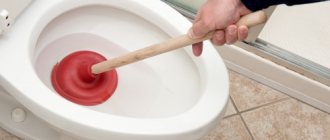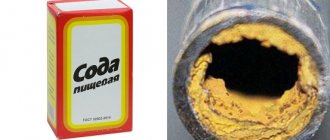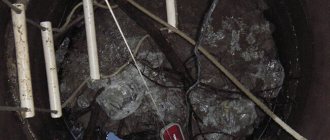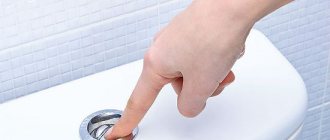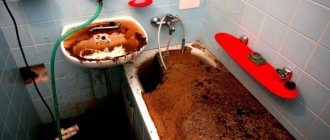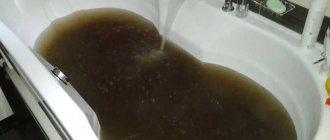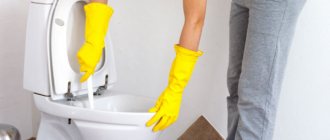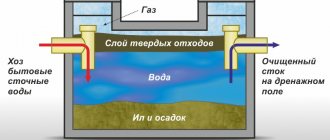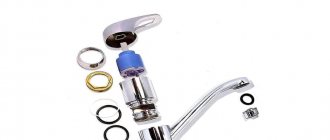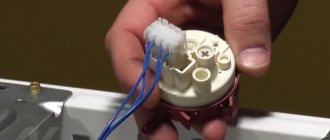A lovingly made renovation in the kitchen, carefully selected interior decor elements, beautiful dishes - in the morning you usually don’t want to leave your cozy nest. So you went out into the kitchen in the morning, prepared to make yourself a cup of coffee and some... What is that unpleasant smell coming from the sink? Let's let the water through - that's right, the water doesn't go away! Instead of morning bliss, we have a clog in the kitchen sink, what should we do, call a plumber or try to deal with it ourselves? The answers are in our article.
First, let us reassure you that most blockages can be eliminated on your own , without calling specialists. There are several methods; if in your case one of the selected options does not turn out to be effective enough, you can use another. Also, at the end of our article, we’ll talk about preventing clogs in the kitchen sink.
Who is to blame and what to do?
Two eternal Russian philosophical questions are quite applicable to our situation. First , check whether there is a special mesh on the sink drain that does not allow food debris, large fractions of vegetable peels, hair and pet hair to freely penetrate into the sewer pipe and form such a delicious plug there, mixing with fat.
If there is no mesh , only you are to blame, how to remove the blockage - urgently go to the hardware store for a miracle mesh.
But there may well be a situation where the fat washed off from the dishes remains on the walls of the sewerage elements and catches the smallest food debris and so on. A clog forms, just not so quickly, not once a week, but once a year , and then one day, not a wonderful day, the water stands in the sink, and the plastic mesh, on which so much hope is placed, drifts on the surface of the water.
What should I do? Let's roll up our sleeves and get down to business.
But the owners are not always to blame; let’s list all the causes of blockages:
- the fine litter already mentioned above (food remains, fat, threads, hair);
- corrosion of pipes (typical of old housing stock);
- defects in the operation of the sewer system (improper installation of the siphon, depressurization of the pipeline, etc.).
In our article we will analyze options for action for the first, most common reason. If old pipes are corroded, they become brittle - in this case, they should be replaced with more modern building materials (in a plastic pipe, for example, there will be no such deposits).
If there are defects in the sewer system, specialists should be invited to diagnose and fix the problem.
Causes
Even modern sewage systems sometimes fail: the water in the bathroom does not drain well, an unpleasant odor appears, or worse, the toilet drain is clogged. Why doesn't the system cope with its functions?
Why does blockage occur?
Improper operation will affect stable operation. The problem is directly caused by:
- Household pollution. Particularly harmful are the fatty fractions deposited on the walls of the pipes. Hair and tissue fibers stick to such layers and accumulate in siphons, elbow bends, and pipe joints, forming a kind of mesh.
Hair is the most common source of problems. - High mineralization of water causes the deposition of salts in areas of variable cross-section, where the direction and flow velocity changes.
Limescale build-up. - Plumbing rust is retained by fat and hair plugs, forming an insurmountable barrier.
A plug of oxides and salts. - Accidental or intentional discharge of large food debris, household waste, rags, and household items into the sewer system.
Impenetrable "algae" - Backpressure . A clogged house sewer well is the cause of trouble for residents of the lower floors: the water does not drain, and what is drained from above ends up in your bathtub.
Do not dispose of construction waste through the toilet! A cement-lime suspension and fragments of materials, having accumulated at the lowest point, will completely block the riser.
Factors that have an indirect impact:
- No grids on the drains of sinks and bathtubs; installation of siphons without safety traps.
The result of operation without a strainer. - Route installation errors: non-compliance with recommended slopes and angles; narrowed internal passage.
The slope is not maintained.
Unacceptable bends in the corrugation.
This is not the way to lay a sleeve.
Organization of route turns.
The smaller the internal diameter of the pipeline, the greater the slope along the flow: from 0.02 (2 cm per 1 m) to 0.03 for diameters of 100 and 50 mm, respectively.
- coarse filter
Special cases
A cast iron pipe loses throughput faster than a plastic pipe due to corrosion, greater internal roughness, and the formation of differences in the interfaces of elements. Often they cannot be cleaned due to complete overgrowth and fragility of the walls, which are destroyed by weak impacts.
The likelihood of clogging a combined kitchen and toilet drain riser is higher than a separate one, since kitchen drains are saturated with fatty compounds. The network of the old building is not designed for the simultaneous operation of a dishwasher and washing machine; if the consumption exceeds the design, the water will drain slowly.
Individual sewerage systems for private housing are often equipped with a concrete pit. Due to poor waterproofing, when groundwater rises, the reservoir overflows, and sanitary waste has nowhere to go.
Modern septic tanks are equipped with insulated plastic tanks that prevent infiltration of perched water. Timely emptying of containers prevents stagnation in the bathroom.
There is no blockage, but the water does not drain
It happens that dirty water in the toilet or bathroom does not drain well when the pipes are not clogged. There are several options:
- The riser below the apartment tie-in is clogged . After filling the free volume of the pipe, the liquid stops passing.
- An air lock has formed . With intensive use of toilet and kitchen plumbing, the liquid, acting like a piston, captures air from the pipe, a vacuum occurs, the level of the toilet water seal drops, and rumbles from the neck of the bathtub. With the restoration of air pressure, the liquid that did not have time to escape is forced back. If the discharge of wastewater continues, the pressure does not have time to equalize with atmospheric pressure. The process becomes oscillatory and air pockets form. Closing the vent in the attic or roof leads to similar consequences.
- The membrane is jammed, the pendulum gate of the dry shutter is jammed: the locking mechanism partially blocks the passage, disassembly and repair are necessary.
Traffic jam areas
Pollution preferentially settles when the flow slows down. Stagnant pockets are especially susceptible to overgrowing: siphon elbows, cavities of eccentric transitions, corrugated hoses, sagging pipe strings.
Poorly made connections: misaligned, with burrs, squeezed out seals - potential obstacles for small particles and fibers. Rectangular shaped parts work like inertial mud traps: the flow hits an obstacle, turns 90˚, and the suspension loses speed and precipitates.
A clogged sewer riser causes great inconvenience. Coupling joints, connection to a basement sewer, and a manhole are likely places for deposits.
There is no alternative to replacement
Basic cleaning methods
There are four reliable ways to clear a clogged sink:
- mechanical;
- chemical;
- hydrodynamic;
- using home remedies.
Below we will analyze in detail each of the popular options. The hydrodynamic method is the least popular, since hydrodynamic sewer cleaning is carried out with special devices; it is an effective cleaning method, but the devices themselves are not very common.
To begin with, you can run a sufficient amount of hot water, the fat will dissolve, if the plug is small, it will break up and go through the pipes. In the future, it will only be necessary to carry out preventive measures to avoid clogging; we will discuss them below.
If hot water does not clear the blockage, then the problem is more serious; we will solve it in other ways.
Removing a clog in the kitchen sink
How to clear a clogged kitchen sink using improvised means
In general, all methods can be divided into chemical and mechanical. First we will talk about the first ones and start with the people's councils. What if you need to act now, but there is no opportunity to buy a special product? Use what you have in almost every home.
Soda, salt, vinegar
They help break through a very small plug and remove the unpleasant odor. There are three recipes.
- Mix one mug of soda and half a mug of rock salt, dissolve them in water and pour it all into the pipe. After five or ten minutes, turn on high pressure hot water.
- Drain the sink if a lot of liquid has accumulated in it. Pour a glass of soda into the drain, pour a glass of 9% vinegar on top. Close the drain and leave for half an hour. After the break, everything needs to be washed off with boiling water.
- Add salt and baking soda overnight so that no water comes into contact with them during this time. Dissolve them in the morning.
Instead of soda, you can use citric acid.
Remember that exposure to high temperatures is contraindicated for a plastic siphon. What to do if you couldn't solve the problem? We'll tell you how to unclog a kitchen sink in this case.
Household chemicals
There are many products sold in stores to remove traffic jams. They come in dry, gel and liquid. You need to choose a suitable solvent based on the characteristics of the material that needs to be cleaned and the degree of contamination. Some of them cannot be poured into plastic. This information is indicated on the packaging.
The most popular brands are “Mole” (several procedures and two bottles may be needed), “Bagi Pothan”, “Sanox Clean Stock”. They are sold in different forms, but most often in liquid. Other names: Tiret Turbo, Sanfor, Selena, Chirton. Good reviews about Deboucher. The liquid does not damage fragile materials, breaks down fat and softens solid waste, operates within a few hours and is economically used.
Manufacturers advise being especially careful with Pothan granules and moving away when using them. They have a very pungent smell.
The algorithm is simple: the required amount of product is poured or poured into the drain for an hour or overnight. The sink must not be used during this time. Afterwards, wash off what is left.
Instagram @ulyana_koronova
Instagram @defrem.com.ua
Follow the rules when working with household chemicals
- First, clean the pipes for 20 minutes with boiling water (steel) or hot water with high pressure (plastic).
- During the process, be sure to wear gloves and open a window or vent so that the room is well ventilated.
- If the composition gets on your skin, wash it off immediately with plenty of cold water without soap.
The following method is used separately or in addition to the two listed. But it’s better to work together.
plunger
Another item that every home probably has. You shouldn't rely on it if a dense plug has formed in the drain, but small dirt can be cleaned without problems.
So, what to do with a plunger if your kitchen sink is clogged?
- Pour some water into the sink and tightly close the drain hole with a plunger. If there are two sections, you will need two plungers at the same time. If there are none, cover the second one well with a damp cloth and hold it with your hand.
- The overflow hole, if there is one, is also closed - with a rag and your hand.
- Press the plunger several times and pull it sharply towards you.
- Check the rate of water drainage and repeat the procedure if necessary.
You can use a regular glass as a tool. However, this will only work for very minor stains.
Pixabay
Overflow hole that needs to be closed
Instagram @muzhnachas.bytovyeuslugi
Vacuum cleaner
This method can be called experimental. There is no certainty that it will work. To make everything work, you will need a powerful vacuum cleaner with a blowing function. The pipe must be wrapped with a rag, placed in the drain hole and turned on the device. According to the plan, the plug should collapse from the created pressure.
Plumbing tools
The kitchen sink can become so clogged that none of the previous methods will work. In this case, a more complex procedure cannot be avoided.
- Cable. The most common device. You can buy it at a hardware store or make it yourself. You need to be careful when cleaning plastic parts - they can be easily damaged.
- Flexible shaft. A thicker and longer cable wrapped in a spiral. Suitable for wide pipes. Used to destroy old contaminants formed in hard-to-reach places.
- Wire. Small diameter wire with nozzles. It can be used to remove objects that have fallen into the drain and remove blockages. It deforms when turned, so it is considered an impractical and disposable tool.
- Metal tape. A narrow strip of 2-3.5 cm with a small tip. Penetrates long pipes well, convenient and durable.
How to use the cable
- Take the tool by the handle and push it in, turning it clockwise.
- When you come across a clog, increase the intensity of your movements.
- Remove the debris and then run water into the hole. At first the pressure should be small.
- Before you begin, check the integrity of the cable and whether the handle and attachments are firmly attached to it. You can use a metal hanger instead. It is cut with wire cutters so that there is a small hook at the end.
Open a window or window - the smell during work can be very unpleasant. Afterwards, treat with household chemicals to wash off the grease.
Instagram @masterphc
Disassembly of the structure
Sometimes this is the best way to fix the problem. Debris can accumulate in the siphon, and it can only be cleaned by separating it from the rest of the plumbing or after partial dismantling. The corrugated pipe also collects grease on its surface, making it difficult for the sewer system to function properly.
You don't need any special skills to figure it all out. You will need a wrench, a bucket or basin, a rag, a screwdriver, a cork pusher, and a dirt remover.
How to disassemble the structure
- Place a container under the siphon. It is filled with water and it will pour out as soon as you remove part of it.
- Unscrew the cleaning hatch cover at the bottom with a key if you have a standard model.
- If it is bottle-shaped, remove the sump with your hands.
- Remove all debris and rinse under running water.
- A plug in a pipe can usually be removed without any problems using a cable, and the fat will dissolve in boiling water with household chemicals or soda.
Sometimes the siphon does not imply the possibility of partial dismantling. In this case, it is removed completely by unscrewing the upper and lower fasteners.
Instagram @momoffarmboys
Instagram @bronzastudio1
- Cleaning
11 things you should never flush down the drain unless you want to deal with clogs
Mechanical cleaning of sewer pipes
At home, you can mechanically clean pipes with a plunger or plumbing cable.
The plunger is a time-tested invention, inexpensive, and lasts a long time. You should buy a separate plunger for the kitchen; for hygiene reasons, you should not use the same one as in the bathroom.
The most reliable plunger is a wooden handle and a rubber pump base; plastic options are not so reliable. How to use it? We install it exactly above the sink drain, make sure that the rubber fits tightly to the bottom of the sink, and let the water flow. Let's take in enough water so that the rubber part of the plunger is under water, press vigorously with all our hearts a dozen times. If the blockage is small, the water will whistle down the drain. It is done!
What to do if your kitchen sink has two sections? Ideally, you should have a pair of plungers and work with them at the same time - this will provide you with excellent cleaning of the sewer system. If you don't have a second kitchen plunger, simply cover the other drain hole with your hand or a rag.
How to clear a clog without a plunger? If you don’t have it on your household, you can imitate its work with a glass, a hand in a rubber glove, or a rag. The principle of operation is the same: close the drain hole, fill with water, and sharply pull up.
Cleaning with a plumbing cable is not as simple as working with a plunger. But you can cope with it too! The cable is purchased at the store and must be used carefully.
The siphon is removed, the end of the cable is inserted there, with rotational movements of the handle the cable is pushed inside the sewer pipe and either crushes the resulting plug, or you take this mass out and throw it away. After installing the siphon in place, run hot water thoroughly. Enjoy the purity and freshness you deserve.
When working with plumbing cable, observe the following rules. The cable must be in good condition, without damage, the handle must be securely fastened to it.
You should rotate strictly in one direction at a measured speed; moving the handle randomly can damage the pipe. If suddenly the end of the cable gets stuck in the sewer, only in this case should you very carefully and slowly turn the handle in different directions until the obstacle is passed.
It is more convenient to carry out this procedure with two people - one regularly rotates the handle, the other controls the cable.
In modern apartments, the entire sewage system is interconnected. Before you start working in the kitchen, take a minute - go to the bathroom, plug the drain hole of the bathtub and sink, then go to the toilet and lower the toilet lid. These simple steps, which won’t take up your time and energy, will help you clean your kitchen sink more effectively.
You can also disassemble the drainage elements under the sink and manually clean each part. Only do this job if you are confident that you can handle it.
How to clear clogged pipes with a plunger
- We tightly plug all overflow holes in the sink with a wet rag to block the passage of air and provide a hydraulic column.
- Press the plunger against the drain hole, then sharply pull it towards you. We repeat these steps several times to thoroughly “stir” the cork and break it into small pieces.
- We check the result by releasing a small stream of water.
- Let the hot water flow for a few minutes so that the plug goes down the drain safely.
Tips:
- If you don’t have a plunger at hand and the blockage is not too complicated, you can replace it with a glass or a rag. The steps are the same: press it against the drain and pull it out sharply.
- If you have a two-section sink, then you need to have two plungers and use them at the same time. That is, when cleaning the drain in one bowl of the sink, you need to close the drain in the second. This will create more suction force. If there is no second plunger, then close the second drain hole with a damp cloth and press it with your hand.
Chemistry comes to the rescue
The choice of chemicals for cleaning sewer pipes is extensive - in any hardware department you will find something that you can afford.
The assortment is large - gels, granules, powders. In such chemical compositions, the active substance is either an alkali or an acid. Whatever you choose, the first thing you should take care of is your own safety.
Aggressive chemistry will not improve your health if you accidentally drop it onto your palm, so let's talk about precautions.
We open the windows, put on a protective mask and goggles, and wear thick rubber gloves on our hands. If the windows of your house face different sides and it is possible to provide cross ventilation, do it.
Never use two different cleaning chemicals at the same time, even with the best intentions - compounds can form that will harm not only the sewer system, but also you.
If you are a resident of an old housing stock with cast iron pipes, this method is not suitable for you. If you have plastic pipes, you should not increase the contact time of chemicals and elements of the sewer system prescribed by the manufacturer. By the way, the label should say that it is intended for your type of pipe.
If the blockage problem has been acute for quite a long time, perhaps one chemical filling will not be enough for you. Therefore, wait the allotted time (read the label), spill hot water and use the services of a trouble-free plunger. Together, both methods will definitely help you!
What if there are children and animals in the house? And you don’t want to use aggressive chemicals? Isn't there a more gentle way? There are such recipes, and we will definitely tell you about them.
Chemicals for cleaning sinks
To remove blockages in pipes in the kitchen, you can use not only soda and vinegar, but also a variety of chemicals that can be found in household chemical stores. Most often they are offered in three versions: liquid, powder or granular. Their main active component is an aggressive alkaline or acidic component.
To remove blockages in pipes using household chemicals, you need to do the following:
- Prepare a small amount of boiling water and pour it into the drain hole.
- Now add the cleaning agent there and wait two to three hours.
- Finally, pour a large amount of cold water over the suspected area of the clogged drain.
It is very effective to use chemicals to clean metal pipes, as they not only help clear blockages, but also remove rust from the walls.
be sure to follow safety rules when using chemicals Do not allow aggressive substances to come into contact with the skin or mucous membranes, otherwise this may lead to a chemical burn. To protect exposed areas of the body, use gloves and be careful not to splash the product too much.
Baking soda, vinegar and lemon are useful for more than just lemon pie
Those who don’t like radical chemicals can always turn to homemade sink cleaning recipes. You can break through a cork using various substances that any housewife can find.
There is an opinion that keeping your apartment clean can be done by having a sponge, baking soda, lemon (citric acid) and vinegar on hand.
Mirrors and windows are rinsed with a vinegar solution; it has dust-repellent properties and does not leave streaks. Citric acid removes scale from teapots one-two-three times. Use baking soda to make your kitchenware shine. The list goes on for a long time. But let's turn to our problem - there is a blockage in the sink.
To remove a garbage plug, try any of the effective recipes below.
Soda and vinegar
Take 200 g of soda, pour it into the sink drain, add 250 ml of 9% vinegar, close the hole tightly. A rather caustic foam is formed, which will cope with the problem.
After half an hour, turn on the hot water, skip a few minutes to achieve perfect cleanliness of all elements of the sewer system. Cleaning should be done with the windows open.
Lemon acid
Take 100 g of citric acid, pour it into the sink drain, add a glass of boiling water, and close with a stopper. After half an hour, run hot water for a few minutes.
Alka-Seltzer
An original way to clean the sink siphon is to use a home first aid kit. Alka-Seltzer is perfect for solving our problem. Place 2-3 tablets in the drain, pour in 250 ml of 9% vinegar, close the drain hole. After a few minutes, run hot water.
In conclusion, let's talk about preventing a clogged kitchen sink, because many problems will not become so if we do not allow it ourselves.
Removing clogs with soda
Regular soda can help you in the fight against operational blockages:
- Take a glass of soda and pour it into the drain hole;
- Now add a glass of vinegar there, which will enhance the effect of soda;
- Wait 15 minutes for the chemical reaction to complete;
- Pour a glass of hot boiling water, then open the tap and let the tap water run.
enhance the effect of soda by adding 5 tablespoons of washing powder or bleach to it. For a better effect, you can pour not boiling water into the drain hole, but fresh potato broth. It will help eliminate the unpleasant smell of sewerage.
You can also
use Alka-Seltzer anti-hangover tablets instead of soda. They are used in a similar way to baking soda and vinegar. Using tablets, you can remove a blockage in the pipe, and in addition to this, remove the unpleasant odor of sediment accumulated in the drain hole.
The above remedies are effective not only as a means to fight quarrels, but also to prevent their occurrence.
Five materials that should not be washed off
Below is a list of what is prohibited from flushing down the sink:
- Egg shells. Because due to the presence of other dirt stuck to the pipe, the shell sticks to it and layers even more debris on itself. It is also capable of scratching pipes with its pointed edges;
- Fat. It instantly sticks to the walls and is very difficult to remove. After they have washed the greasy dishes, they need to pour a few glasses of hot water into the sink. It is recommended to periodically pour a boiled kettle of water into the sink as a preventative measure a couple of times a month. Boiling water helps grease to leave the pipe walls and not accumulate on them, which prevents pipes from clogging;
- Coffee grounds. The risk of clogging the pipe with it is quite high, so it is better not to take unnecessary risks, but to pour the remaining coffee into the trash bin;
- Flour. By itself it does not pose a danger, but in contact with water there is still some danger. As the flour settles on the surface of the pipes, it mixes with water and acquires a sticky consistency. With the help of which other debris can easily be attached to the pipe;
- Paper. Some types of paper are not able to get wet quickly, which often causes poor water flow in the sink.
Poor water flow can also be caused by problems with the siphon. Perhaps yours is too narrow or curved; this means that debris cannot move along it and gets trapped in some of its parts. Debris accumulates in this area and eventually forms a plug, preventing the water from draining.
Rust may be the culprit if you have old pipes that haven't been replaced in a while. Rust accumulates and grows from year to year, thereby narrowing the lumen of the pipe.
As you can see, there are many reasons why a bathroom or sink does not drain well. We figured out the reason, but what next? After all, it’s not enough to just understand what happened; you need to start taking some action to solve the problem.
